Have you ever experienced repeatedly thinking about possible negative consequences of an action you haven’t done? How about being unproductive because of the countless thoughts running through your head? If you have, don’t worry because you’re not alone. I have experienced them, too.
I remember when I had to do an impromptu speech for class, and I kept thinking of what might possibly go wrong – such as not knowing what to say, not being familiar with the given topic, or experiencing mental block in the middle of the speech.
Overthinking can get exhausting, so to better deal with it, I had a chat with Dr. Raymond John S. Naguit, founder and national chairperson of the Youth for Mental Health Coalition, Inc.

What is overthinking?
Dr. Naguit describes overthinking as a phenomenon wherein we tend to get ahead of an action or an event before we do or experience it. Rumination is rooted in overthinking about the past, while anxiety involves overthinking about the future. Sadness, guilt and anxiety are normal and valid, but when these emotions hinder our growth and development, then we may have to consider a formal diagnosis.
Dr. Naguit explains that though overthinking in itself is not a clinical disorder, it can be a symptom of a mental disorder. He cited some signs when we’ve fallen into the pit of overthinking:
When we don’t live in the present moment
Overthinking takes away our focus on the here and now because we are too busy projecting into the future or digging into the past. I’ve noticed this in myself. Sometimes, I don’t even notice how my food tastes like because I keep thinking about the things I need to do. Scenarios like this make me question why I overthink since it prevents me from enjoying the little things.
When it affects our work
Though thinking can help us mentally organize our to-do list, it becomes a concern when it keeps us from doing the very things we think about.
When it affects our relationships
Overthinking about what people will think or how they will respond to our actions may keep us from taking risks and forming healthy relationships.
When it causes deviant behavior
Dr. Naguit states that this is when we become “overly cautious about doing a certain action or going to a certain place.” This can sometimes contribute to the stress that we experience, which may lead to mental disorders which, Dr. Naguit assures, is not an immediate effect of overthinking.
But if negative thoughts are repetitive, Dr. Naguit points out that it is possible to develop an anxiety disorder from overthinking. If we no longer have control over our emotions, feelings, or thoughts, it is best to seek the help of a professional.
Why do we overthink?
Dr. Naguit explains that overthinking is sometimes due to the “many stimuli that we’re faced with.” An example is the COVID-19 pandemic, which has given rise to health risks, political issues, and economic concerns. Too much stimuli can be overwhelming because they exceed our capacity to cope with different stress points. This can contribute to overthinking since we find it difficult to banish these thoughts.
Dr. Naguit says it is normal for us to sometimes overthink, especially if we have many concerns or tasks. He adds that our reactions to a current situation are sometimes a result of previous experiences. Someone who had been bullied in school may approach going to school with caution and anxiety.
To manage overthinking, Dr. Naguit suggests the following steps:
Express our feelings.
Whether we’re experiencing heavy feelings or bothersome thoughts, we need to release them. Dr. Naguit suggests exorcising emotions on paper; some have “worry journals” that house their thoughts. We can also share our concerns, no matter how irrational, with trusted friends. Sometimes it just takes somebody to tell us that everything will be okay to make us feel better.
Divert our attention.
Dr. Naguit states there are times when we simply cannot control what goes into our minds. However, we can look for a positive diversion. We can try exposing ourselves to another source of stimulus – such as making art, watching television, or exercising.
Understand our sphere of influence.
How do we differentiate the things we can control from those we cannot? Dr. Naguit advises to map out our sphere of influence. For example, instead of stressing over the number of COVID-19 cases every day, it is better to focus on wearing our masks and washing our hands because these are the things we can control. Doing so will not make us feel so helpless and will give us a sense of agency.

Practice mindfulness.
Mindfulness is the concept of being aware of the present moment. Because overthinking – or anxiety – is sometimes caused by our fears for the future, the idea is “to reorient [our] attention back to the present moment,” says Dr. Naguit. Mindfulness-based practices like meditation and mindful eating are deliberate and help maximize our five senses to “reorient [ourselves] to the present moment or to the current environment.”
Dr. Naguit adds that part of mindfulness is accepting that we cannot control our thoughts. Thoughts will inevitably enter our minds, and the more we try to control them or shield them, the more stressed we get. He advises to simply recognize and acknowledge our thoughts, and allow them to flow. Then take deep breaths and one by one, let them go.
Physically release our stress.
Some psychologists recommend using stress balls as a means for physical release. Dr. Naguit adds that one of the things he teaches is “progressive muscle relaxation,” wherein patients “cyclically flex and relax [their] muscles.”
Get enough rest and sleep.
Rest is also an important part of mental health intervention. Dr. Naguit explains that when we don’t get enough sleep, we become irritable and tend to conflate things, which then make us overthink. Interventions for physical wellness also contribute to our mental well-being.
When we are doing something, it is best to have our full attention on the task at hand so we can perform our best. However, there are times when certain thoughts pop-up in our minds– and this is perfectly normal. You don’t have to overthink overthinking!
Overthinking is definitely something I can live without. And that impromptu speech I mentioned in the beginning— the one I’d been so worried about? It turned out fine! I knew just what to say about the topic and I finished the speech without a problem.
We don’t have to worry so much or about things because often, they turn out fine in the end. If not, then that’s fine, too. We’ll just learn from the experience and improve ourselves.
If you or someone you know is struggling with a mental health condition, know that there are people whom you can talk to. Get in touch with them through these numbers:
National Center for Mental Health Crisis Hotline
0917-899-8727
UP Diliman Psychosocial Services – Free Online Counseling
0916-757-3157
0906-374-3466
psycserv.upd@up.edu.ph
Philippine Mental Health Association – Free Online Counseling
0917-565-2036
PMHA Facebook Messenger
Philippine Psychiatric Association – Free Online Counseling
0918-942-4864
Pregnancy is meant to be an exciting journey for expectant couples. But as the world grapples with the rising number of COVID-19 cases, this joyous experience is marred by uncertainty and worry.
According to the Centers for Disease Control and Prevention (CDC), pregnant people may be at an increased risk for severe illness from COVID-19 as compared to non-pregnant people. There may also be an increased risk of adverse pregnancy outcomes, such as preterm birth among women with COVID-19.
- Stay home and limit your interactions with other people.
- Strengthen your immune system by taking your prenatal vitamins, eating nutritious food, and getting enough exercise and at least eight hours of sleep.
Our country’s natural environment is in a dire state. According to the United States Agency for International Development (USAID), the Philippines is highly vulnerable to climate change with its increased weather events, and rising sea level and temperatures. A study conducted by the World Health Organization (WHO) in 2018 revealed that the Philippines ranks third in deaths due to air pollution. The country also ranks third as a source of plastic pollution in the oceans according to a 2015 report by Ocean Conservancy.
Pro-environment speeches always talk about how we need to save the environment for the next generation. But to solidify this advocacy, we need the next generation to fight alongside us in the name of environmental protection. And one effective way to do this is through children’s books that nourish young minds in engaging ways.

According to the 2017 Readership Survey by the National Book Development Board, picture books and storybooks for children are the second most-read book genre among respondents. Among children and even young adults, over 72% read the said genre.
Building on these statistics, Panahon TV celebrates Buwan ng Wika this August by featuring writers with a heart for Mother Nature. Their children’s books written in Filipino capture the next generation’s imagination, while instilling in them a love for the environment.
Writers slash Eco-Warriors
 Liwliwa Malabed
Liwliwa Malabed
With 16 children’s books published and 4 more waiting in the wing, Liwliwa Malabed has been writing for young readers for 18 years. Some of her books have been recognized by the Philippine Board on Books for Young People through the PBBY-Salanga Writers’ Prize. We shine the spotlight on her environmental book Luntian, Ang Bungang May Pakpak (Luntian, the Winged Seed Pod), illustrated by Aaron Asis and published by Lampara Books. The story talks about Luntian, a seed pod who dreams of becoming a sturdy forest tree like her mother. While chasing his dream, Luntian goes on an adventure, meeting a Northern Luzon giant cloud rat and a Rafflesia, the world’s largest flower.

How did the concept for the book come about?
Luntian was written after a visit to the Makiling Center for Mountain Ecosystems (MCME) in Los Baños, Laguna. There, I saw towering native trees like the Red Lauan. Our guide told us about indigenous species that depend on these trees to survive. Somehow, the idea that one tree can support all these creatures stuck and I went back to Manila with the imprint of the lauan tree in my mind.
How did you craft the story?
First, I researched on dipterocarps. I learned about how their seeds have wing-like parts so they can ride the wind and reach far. I also looked up the animals and plants that live on these trees. I personified my characters because I needed the seed pod to come alive, to have an active role its story. It is still a seed, yes— but with an impatient desire to become a giant.

What do you think are your book’s strongest points?
I made a conscious decision to write it in Filipino and I am glad I did. A story resonates more with children when told in a language they can easily understand. I am also happy with the story within the story part of the book, that Luntian wants to grow into a giant tree so she can be a home to forest creatures because of a tale told by Lolo Ninok, a Philippine scops owl. The illustrations by Aaron Asis are wonderful! The artist’s work is the puzzle piece that completes the narrative.
What do you hope children will learn after reading your book?
I am hoping that children will be more aware of how magnificent and valuable trees are, that planting native trees is beneficial to the environment because they are more resilient against strong winds and flooding brought about by typhoons. Also, endemic species prefer to live in native trees.
 Jomike Tejido
Jomike Tejido
Jomike Tejido is both a writer and illustrator with over 50 children’s books under his belt. In 2010, he won two National Book Awards for writing and illustrating Tagu-Taguan, and for illustrating Lub-Dub, Lub-Dub about pioneering pediatrician Fe del Mundo. Also an architect, Jomike has been writing children’s picture books since 2001. One of them is the Anvil-published endangered species series, which features lovable stories about the pawikan (marine turtle), dugong, Philippine eagle, and tamaraw (Mindoro dwarf buffalo) among others.
 5 of 7 books in Jomike’s endangered species series
5 of 7 books in Jomike’s endangered species series
How did the concept for the endangered species series come about?
The series was commissioned by Anvil Books in 2007 and it was my first experience in having a commissioned set of three stories. Then the series picked up and more titles sprang. They must have commissioned me for it due to my long-running daily comic strip that dealt with the lighter side of environmental issues. Mikrokosmos in the Philippine Daily Inquirer ran from 2000 to 2007.
How did you craft the stories?
I took into consideration some pointers I learned from the writers’ workshop I attended, wherein a child psychologist talked about a child’s psychological needs. From there, I made my stories more mundane and specific. Pao Tamaraw was inconsiderate and playful, while Gilas Agila was boastful and had a superiority complex. All these traits are flaws relatable to children, and personified by animals in their habitat. As children can sometimes act like “wild animals,” I could easily relate animals to kids. I worked with Haribon Foundation, and I had a pack of endangered animal flashcards I used as my main list. Then I worked with credible websites to fill in other factual details.

What do you think are the strongest points of this series?
The strongest points are my low word count (thus short storyline), relatable characters and whimsical digital art. I made it a point that the science part wasn’t didactic or rammed into the readers’ minds.
What do you hope children will learn after reading these books?
I hope that children can learn to love animals, especially those endemic to our country, and not feel that just because they are local, they are uncool. I’d like young Filipinos to be proud that these creatures come from their land. I want them to know where these animals live and what they eat, just like how kids are familiar with foreign creatures from TV or books.
 Augie Rivera
Augie Rivera
Writing for the classic Filipino children’s show Batibot propelled Augie Rivera to be a children’s book writer. His books have received recognition from award-giving bodies, including the prestigious Carlos Palanca Memorial Awards for Literature. Recently, he was awarded with the 2020 Gawad Pambansang Alagad ni Balagtas for Children’s Literature in Filipino. Last year, Augie’s 19th book, Bayan ng Basura, illustrated by Jill Arteche, was published by Adarna House and Greenpeace Southeast Asia – Philippines. The protagonist is a pawikan who, after a storm, ends up in the deep end of the ocean littered with trash and ailing fellow sea creatures.

How did you come up with the story’s concept?
The book was commissioned by Greenpeace because they wanted to tackle the issues of single-use plastics and ocean pollution. I based the story on real-life events, such as the marine turtle that had a plastic straw shoved up its nose in Costa Rica in 2015. I also read up on the dead whale in Compostela Valley which had 40 kilograms of plastic in its stomach. Then I saw a footage of a British diver in Bali who showed the incredible amount of garbage floating on the sea. These bits of news fueled my imagination, which was why my story had a post-apocalyptic feel to it, wherein there was more garbage than sea creatures.
What do you think are your book’s strongest points?
I really like the book illustrations by Jill Arteche. The first time I saw them, the style reminded me of Maurice Sendak’s work. When I met Jill, I found out that Sendak is one of her major influences. When the pawikan was surround by trash, the illustrations were dim. They brightened when the trash disappeared.

What do you hope kids will learn from story?
I want them to be aware that they can do something to solve a big problem such as ocean pollution. They can do their part in their own little ways because that’s how big problems start—from little things. I want them to be mindful of their actions because humans are not the only living things here on earth.

Practicing What They Preach
These writers don’t only write about caring for the environment; in their own homes, they also practice eco-friendliness. Liwliwa, for instance, was brought up by a grandmother who taught her how to reuse and recycle. “At home, we try to be mindful of our carbon footprint, conserving water and energy, and refusing single-use plastic.”
Jomike reuses product packaging, and passes on environmental values to his children. “I teach my kids to save water and energy by turning off faucets and appliances when not in use. I let them watch nature documentaries to expand their world view, and see animals wider than the scope of domestic pets,” he shares.
Ever since Augie moved to Marikina a few years ago, he’s been more conscious of waste segregation. “Once, I accidentally mixed vegetable peel with non-recyclable waste, and I had to go to the City Environment Management Office to either pay the fine of P2,000 or do community work. I never made the mistake again.” When he goes out, Augie brings his own eco bag, straw and utensils. “I agreed to write Bayan ng Basura because I really support environmental advocacies.”
 Linaaw, Liwliwa’s daughter, reads her mother’s book
Linaaw, Liwliwa’s daughter, reads her mother’s book
Telling Mother Nature’s Stories
All these children’s book writers agree—it’s vital to write environmental stories for children.
“It’s important to imbue the love for animals and care for the environment at a young age,” Jomike shares. “Stories like mine aim to foster the love for these creatures by letting kids feel that these characters are like their friends (or themselves), who have flaws like any normal person and can be taught to become better.”
Liwliwa thinks that these stories are more important now during the pandemic. “Nowadays, children are always indoors, and stories connect them with the outside world,” she says. “Stories about the environment make children realize how nature makes it possible for us to live our lives and how children can participate in protecting our planet.”
Augie believes that stories about the environment gives hope to the next generation. “As grownups, we didn’t do our part in saving our planet. So we should raise our children’s awareness on the issues, and encourage them to do their part and hope for a better world to live in.”
The COVID-19 pandemic continues to be in full swing with currently over 20 million confirmed cases worldwide. In the Philippines, the total number of cases has reached 148,000 with over 2,000 people dying from the disease.
But the pandemic isn’t the only crisis the country faces. Right now, the Philippines is in the middle of typhoon season. According to the Philippine Atmospheric, Geophysical and Astronomical Services Administration (PAGASA), more tropical cyclones enter the Philippine Area of Responsibility (PAR) than anywhere else in the world each year. An annual average of 20 tropical cyclones develop in the region, 8 to 9 of them traversing the Philippines.
The peak of typhoon season, wherein 70% of typhoons develop, happens between July to October. According to PAGASA, the country may experience 8 to 13 tropical cyclones from August until the end of the year. More than ever, Filipinos need the weather bureau’s comprehensive and reliable forecasts to help them ensure their safety this pandemic.
 Source: PAGASA
Source: PAGASA
Getting to Know PAGASA
PAGASA traces its roots back to the Observatorio Meteorologico de Manila (now Manila Observatory) a scientific research institution established by the Jesuits in 1865. Involved in the systemic observation of Philippine weather, it first issued typhoon warnings in 1880.
In 1901, the observatorio was re-organized and was formally named as the state’s weather bureau. Today, PAGASA, under the Department of Science and Technology (DOST) is mandated to “provide protection against natural calamities and utilize scientific knowledge as an effective instrument to ensure the safety, well-being and economic security of all the people, and for the promotion of national progress.” (Section 2, Statement of Policy, Presidential Decree No. 78; December 1972 as amended by Presidential Decree No. 1149; August 1977)
With its mission to be a center of excellence for weather-related information, PAGASA seeks to protect lives and properties through its following products and services:
- weather forecasts and tropical cyclone warning
- flood forecasts and warnings
- climatological and farm weather
- research and development
- information, education, and public outreach
- astronomical services
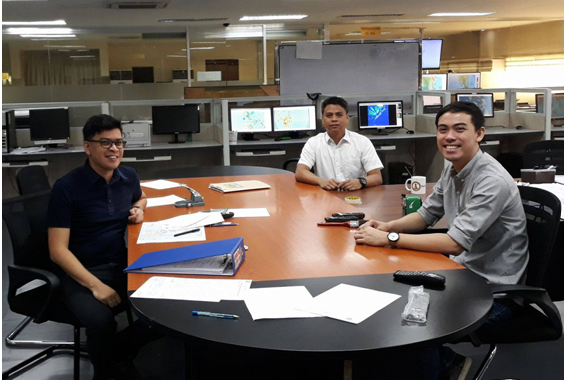 PAGASA weather forecasters before the pandemic (L-R: Nikos Peñaranda, Chris Perez, Ariel Rojas)
PAGASA weather forecasters before the pandemic (L-R: Nikos Peñaranda, Chris Perez, Ariel Rojas)
PAGASA and the Pandemic
The pandemic impacted public mobility, businesses, services, and many other aspects of daily living. According to Chris Perez, PAGASA spokesperson and senior weather specialist, the weather bureau was no exception. “The restrictions put into effect by the national government to prevent the further spread of the virus affected PAGASA’s day-to-day operations in the sense that only a few personnel are required to report to the office. This posed a great challenge in ensuring the continuous delivery of the agency’s products and services despite the limited manpower.”
PAGASA’s limited physical manpower at the office has been supported by work-from-home personnel since the Enhanced Community Quarantine (ECQ) last March 16. Those assigned to report to office are provided company transportation from their homes to the office then back to their homes after a 3-day or 5-day work assignment. Perez adds, “The same personnel are given grocery allowances, and sleeping quarters to rest after their duty. Key personnel such as the PAGASA Administrator and higher officials report to the office when needed—during the event of a tropical cyclone, the processing of payrolls, and other duties.”
Because health vigilance is a must during the pandemic, PAGASA’s weather division has formed a committee to oversee the health and well-being of its employees—both in the office and working from home. “This ensures that the appropriate number of working personnel is met whenever the situation warrants,” Perez explains. “In the case of a personnel getting ‘sick’ and not being able to report for work, this committee will handle the matter in accordance with the national government’s established health protocols.”
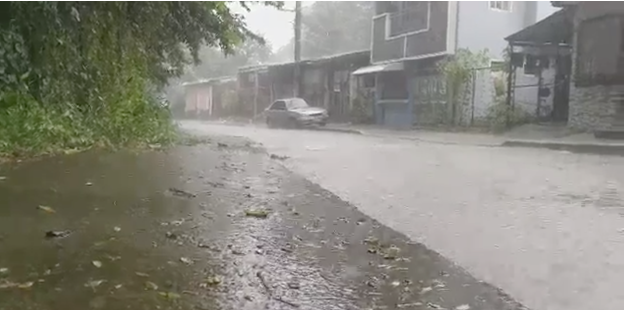 The habagat may enhance tropical cyclones, bringing more rains in the country. (Photo by PM Caisip)
The habagat may enhance tropical cyclones, bringing more rains in the country. (Photo by PM Caisip)
Currently, PAGASA holds webinars to conduct climate forums and educate sectors on the natural hazards the rainy season brings. During the National Disaster Resilience Month last July, PAGASA’s webinars targeted religious organizations and focused on preparedness among children.
Season of both Typhoons and the Pandemic
Since the government’s announcement of the country’s first COVID-19 case in January, 7 tropical cyclones have entered the PAR as of writing.
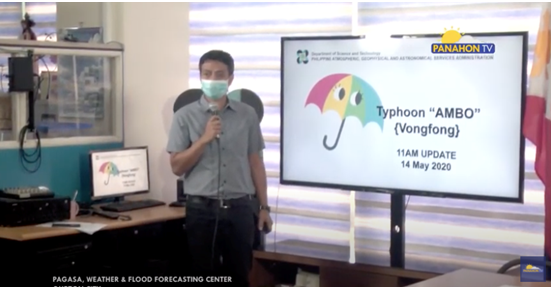 Perez holding a press briefing for Typhoon Ambo last May
Perez holding a press briefing for Typhoon Ambo last May
May 14
Typhoon Ambo (international name: Vongfong) made its first landfall in Eastern Samar. PAGASA recorded five more landfalls that weakened the weather system before it headed inland to Luzon. According to the National Disaster Risk Reduction and Management Council (NDRRMC) last May 20, Ambo caused an estimated damage of Php2 billion in agriculture and infrastructure, and left 5 people dead.
June 11
Tropical Depression Butchoy (international name: Nuri) made its first landfall in Pollilo Island in Quezon. Because Butchoy was expected to produce heavy rainfall in Albay, , the province was placed under disaster “response status.” Butchoy’s rains prompted PAGASA to declare the start of the rainy season in the country last June 12.
July 13
Tropical Depression Carina headed for the Luzon Strait near Batanes and Cagayan. Before leaving, the weather disturbance left over PHP19-million worth of damage in Ilocos Norte in crops and properties.
August 1
Dindo (international name: Hagupit) strengthened from a tropical depression into a tropical storm on August 1. Though Dindo enhanced the southwest monsoon (habagat), bringing more rains, Dindo did not have a direct impact on the country, and exited PAR on August 3.
August 8
PAGASA upgraded a weather disturbance into Tropical Depression Enteng (international name: Jangmi). The next day, it intensified into a tropical storm, enhancing monsoon rains in MIMAROPA, Pangasinan, Benguet, Zambales, Bataan and Antique.
August 9
Just seven hours after Enteng left PAR, Tropical Depression Ferdie developed, raising Public Storm Warning Signal No. 1 in parts of Luzon. While maintaining its strength, Ferdie exited PAR on August 13.
August 13
Tropical Depression Gener entered PAR. No public storm warning signal was raised since Gener was expected to weaken as it moved westward of PAR.
PAGASA’s Crucial Role
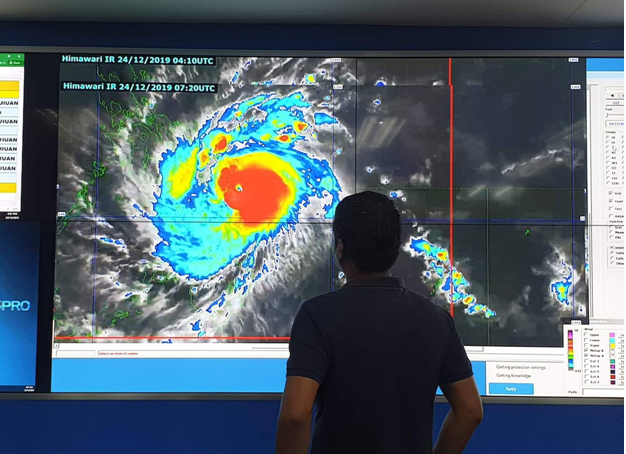 Perez studying a tropical cyclone’s movement
Perez studying a tropical cyclone’s movement
Even before the pandemic, PAGASA has always been an important source of information essential to public health and safety. “PAGASA’s products and services are of vital importance in day-to-day activities,” Perez says. “Matters related to the pandemic can be planned and executed—such as the transport of medical personnel, products and services, or even the usual buying of groceries and medicines of the general public—in accordance with the expected weather.”
Weather forecasts are even more relevant now that natural disasters such as typhoons can hamper health services and damage health infrastructure. According to Christopher Trisos, director of the African Climate and Development Initiative at the University of Cape Town in South Africa, natural disasters can also disrupt the supply of clean water and eat into government budgets already stretched thin by the pandemic response. Physical distancing is also challenging in often-crowded evacuation centers.
Last May, India and Bangladesh were ravaged by Category 5 Hurricane Amphan, leaving over a hundred dead and displacing thousands of families. Partnered with the pandemic, the disaster can impact even more lives.
In the Philippines, the second half of the year marks the time when most tropical cyclones directly affect the country. And coupled with the habagat season commencing from July to September, tropical cyclones can bring continuous moderate to heavy, and even at times, torrential rains, which may cause flooding in low-lying areas and landslides near mountain slopes. These winds and rains, regularly experienced during this period, may inflict damage to properties, causing disruptions in major services such as power, transportation, health and food. “There is a tendency that the current situation may worsen—such as an increase in the number of affected persons or casualties— when there is a disruption to the provision of the these products and services due to weather-related hazards,” Perez explains.
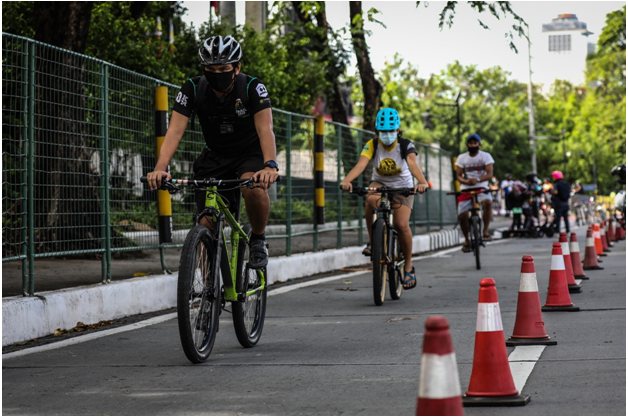 The typhoon season may worsen public mobility already hampered by the pandemic. (photo by Jire Carreon)
The typhoon season may worsen public mobility already hampered by the pandemic. (photo by Jire Carreon)
Right now, PAGASA is testing a new prediction model called the 2-Week Tropical Cyclone Threat Potential Forecast that shows the development of cyclones two weeks before they occur. The agency’s researchers developed this weather forecasting model in partnership with Taiwan’s Central Weather Bureau.
The situation may look grim, but Perez says we can do our part in alleviating it. While we can’t stop weather systems from entering our country, we can slow down the rise of COVID-19 cases in the country. “Heed the government’s call to just stay at home as much as possible, and follow the established health protocols being implemented,” Perez urges. “Lastly, make it a habit to monitor every day the various PAGASA weather updates as these may guide you in planning your day-to-day activities.”
- With additional reports from George Gamayo
International Summit Council for Peace
World Leaders to Address “Rally of Hope”
August 9, 2020, at 8:40 AM (Manila time)
PRESS RELEASE
Despite material advances and the amassing of unprecedented wealth, serious global problems remain unsolved. This is all the more striking when it is seen alongside worldwide efforts to maintain peace, resolve conflicts and end poverty by major international peace-keeping bodies, public and private.
Territorial disputes, religious and racial discord, the collapse of family values, and an aggregate of environmental issues are flaring up on all continents. Added to this is the COVID-19 pandemic which has caused catastrophic economic debt. It seems like a perfect storm.
Just such dilemmas drew the late Rev. Dr. Sun Myung Moon and his wife Dr. Hak Ja Han Moon to speak out for the realization of an ideal world. Their vision: one human family bound together by the love of God. For decades, they have advocated the philosophy of interdependence, mutual prosperity, and universal values which challenges us with the novel concept of seeing our own purpose in life fulfilled in the well-being of others.
To emphasize these values and help address related problems, the Universal Peace Federation (an NGO in general consultative status with the Economic and Social Council of the United Nations), will be hosting the latest in a series of on-line virtual summits. The Rally of Hope will be held August 9, 2020 beginning at 8:40 AM (Manila time). The official theme is, “One Million Rally of Hope for the Realization of a Heavenly Unified World of Interdependence, Mutual Prosperity, and Universal Values.”

Ban Ki-moon, former UN Secretary-General and Chairman of the National Council on Climate and Air Quality in Korea, will give the welcome address. Following this, Rev. Paula White, spiritual advisor to President Donald Trump, will give her special remarks. Congratulatory messages from the Hon. Chuichi Date, former President of the House of Councillors of Japan, and the Hon. Newt Gingrich, former speaker of the United States House of Representatives will follow.
Interspersed with first-class entertainment, keynote addresses will be given by H.E. Hun Sen, Prime Minister of Cambodia; H.E. Macky Sall, President of Senegal; the Hon. Brigi Rafini, Prime Minister of Niger; H.E. Dick Cheney, former Vice-President of the United States of America; and other world leaders. Finally, Dr. Hak Ja Han Moon, co-founder of the Universal Peace Federation and host of the Rally, will give her keynote address.
E-certificates will be available upon request. In addition, all participants will have a chance to learn more about the Universal Peace Federation and its worldwide movement.
To register for the Rally of Hope visit http://www.upfasia.org/rallyofhope-register.
UPF is an NGO in General Consultative Status with the Economic and Social Council of the United Nations 32 Samar Avenue, Brgy. South Triangle, Diliman, Quezon City Telephone number: (63)(2)924 1833 Website: www.upf.org Email: upfphils.pr@gmail.com
Time flies when you’re having fun, and seems to slow down when you’re in a less desirable situation. But time is more than the numbers glowing on our phones and watches; it is a fascinating ode to astronomy.
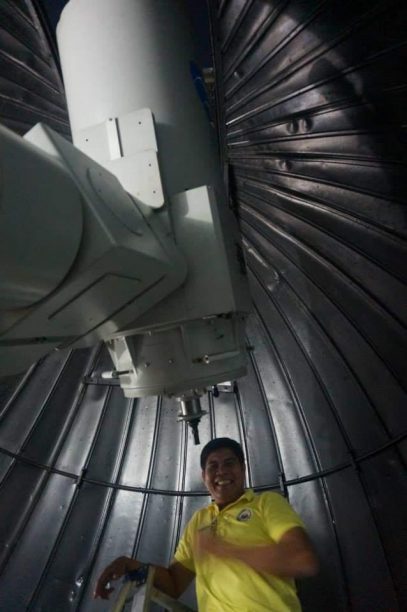 Raymundo with a 45-cm GOTO Telescope, the largest optimal telescope in the country, at the PAGASA Astronomical Observatory in the University of the Philippines.
Raymundo with a 45-cm GOTO Telescope, the largest optimal telescope in the country, at the PAGASA Astronomical Observatory in the University of the Philippines.
When Electrical Engineer Mario Raymundo first entered the Philippine Atmospheric, Geophysical and Astronomical Services Administration (PAGASA) office in 1993, he was assigned to the weather’s bureau’s time service unit. Here, he learned how time could be measured by observing the movement of celestial bodies, and how time zones in different parts of the world are based on the fact that it takes the Earth one hour to turn 15 degrees.
As time went by, it seemed almost natural for Raymundo to gradually expand his knowledge and duties to include astronomy. “As an engineer, I was well-versed in mathematics, including trigonometry. But in astronomy, I learned spherical trigonometry to make observations on the celestial bodies.”
Decades later, Raymundo is now chief of the PAGASA Astronomical Observation and Time Service Unit. “We use a 45-centimeter telescope to observe variable stars. During the daytime, we study and photograph sun spots.” Sun spots or dark spots that appear on the Sun’s photosphere may have an effect on the Earth’s weather patterns. Meanwhile, variable stars or stars that change their brightness are studied to possibly discover other stars and signs of life in the galaxy.
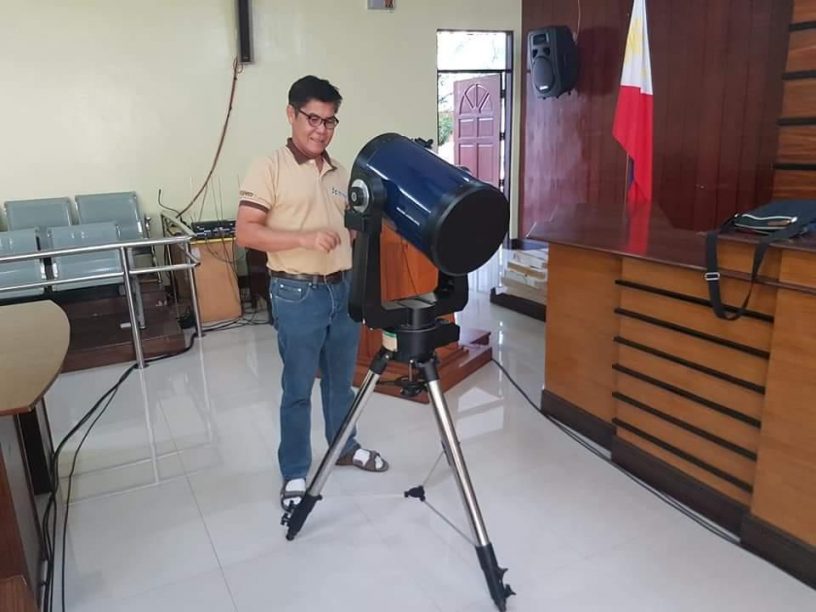 Raymundo with a compound telescope
Raymundo with a compound telescope
Astronomy for Filipinos
Raymundo admits that the study of astronomy in the Philippines is limited because of the lack of funding for high-cost equipment. “Astronomy equipment is very expensive. A 1-meter telescope alone costs a million (US) dollars, which is roughly 50 million pesos. You can feed a lot of Filipinos with that amount.” Still, Raymundo believes that PAGASA provides a good foundation for future Filipino astronomers. “We have to start somewhere to impart the knowledge to future generations. Before the pandemic, we regularly visited schools with our mobile planetarium to conduct lectures.”
Despite the challenges, Raymundo says astronomy remains significant for Filipinos. “A lot of Filipinos are hungry for astronomical knowledge. In science textbooks in schools, only 7 to 8 pages are dedicated to astronomy, offering only general facts. When we conduct lectures, we give students direct knowledge. Through the planetarium, they better understand why celestial bodies are positioned in certain ways, and the importance of the Polaris or North Star. It’s easier to explain things that way.”
 Annular Solar Eclipse in December 2019 in Balut Island in Saranggani, Davao Occidental
Annular Solar Eclipse in December 2019 in Balut Island in Saranggani, Davao Occidental
 Training in Spain on Astronomical Observation which lasted for several months
Training in Spain on Astronomical Observation which lasted for several months
Astronomy saves lives
But astronomy is not only a passive observation of the skies; it can also save lives. In 2013, an asteroid about the size of a six-story building blasted over Chelyabinsk in Russia. Its explosion generated a shock wave that shattered glass and injured over a thousand people. “Outer space can bring disasters,” Raymundo says. “In reality, thousands of meteors enter our planet, but they usually disintegrate before hitting our surface. The one that exploded in Russia was unexpected, so we need people to be aware that this kind of disaster is possible.”
On July 15, Panahon TV will host a free webinar called Understanding Space with Raymundo as the speaker. “I’m excited because it’s my first time to conduct an online lecture. It’s a different approach and I’m looking forward to the results.” When asked what he’s excited to share with the webinar participants, Raymundo says, “I hope to better explain to them the things they read in books. Everything from the constellations to the zodiac, I will be able to describe in detail.”
Catch Chief of PAGASA Astronomical Observation and Time Service Unit Mario Raymundo in Panahon TV’s free webinar, Understanding Space, on July 15, 2020 at 2 pm. To register, click here: https://bit.ly/2Z7TJa4
Thousands of residents in Batangas have been evacuated due to the continuous threat of Taal Volcano’s major eruption. Last January 12, 2020, the volcano’s main crater spewed small rocks and thick ash that blanketed nearby towns.
As of writing, 11 Batangas towns are under complete lockdown, leaving affected residents no choice but to stay in evacuation areas away from the 14 km-radius danger zone identified by the Philippine Institute of Volcanology and Seismology (PHIVOLCS). Alert Level 4 is raised in Taal Volcano, which means hazardous eruption is possible within days.
Based on the latest records of the Provincial Disaster Risk Reduction Management Council (PDRRMC), 37,355 families or 162,728 individuals are in various evacuation centers.
Together, let’s aim for Operation: Bangon, Batangas. Click on this link for donation details: https://bit.ly/2NHjBEJ
Each night is a chance to behold a divine masterpiece. Just look up and you can see the stars twinkling like gems on the endless black canvas of sky. In movies, lovers often stargaze, naming stars after each other. The idea of actually owning a star and naming it after someone is fascinating, but the question remains: is it possible in real life?
According to the International Astronomical Union, it is impossible to legally buy a star and name it after someone. So be wary of companies that claim to be official star –naming agencies. One of which is the International Star Registry, which used to offer helping clients name a star in honor of their loved ones. But in 1998, the company was issued a violation by the New York City Department of Consumer Affairs for “deceptive advertising.”
This is because the only way for stars to be named legitimately is through the International Astronomical Union (IAU), an association of professional astronomers, dedicated to professional research and education in astronomy. Stars are given names for one reason alone—for astronomers to locate these celestial bodies more easily. In fact, the IAU has dissociated entirely from advertising and commercial practices to strengthen its identity as an international scientific organization.
To name stars, they are first sorted according to their brightness. Proper names are given up to the third brightest stars. Because history reveals that much of the modern math and astronomy we use today originated in Arabia, some of the stars’ names are Arabic, such as Betelgeuse and Dubhe.
Another system that the IAU follows in naming stars was proposed by Johann Bayer of Bavaria. Bayer assigned letters from the Greek alphabet to the brightest stars of each constellation. Using his system, Polaris is called Alpha Ursae Minoris, while Dubhe is Alpha Ursae Majoris.
Meanwhile, faint stars were named through catalogs prepared by astronomers. Frequently used catalogs include the Bonner Durchmusterung, Smithsonian Astrophysical Observatory (SAO), The Yale Star and The Henry Draper published by the Harvard College Observatory. A specialized catalog called the Deep Objective Prism Survey of the Large Magellanic Cloud published by Warner and Swasey Observatory was used to name the Supernova of 1987 (Supernova 1987A), one of the major astronomical events of this century identified with the star named SK -69 202.
These are the only systems accepted and used by the International Astronomical Union.
But in the end, how stars are named doesn’t alter the beauty of the night sky. When darkness reigns, everyone on this planet gets to witness the breathtaking scenery that satisfies our inner astrophiles.
Sources: International Astronomical Union, UW Madison Astronomy
By Charie Abarca, Panahon TV Intern
Because of the increased awareness on astronomical events, such as meteor showers, eclipses and the photogenic super moon, more and more people are capturing these phenomena using their mobile phones and cameras. According to Astronomy Online, this particular hobby, also called astrophotography, seems to be the most popular topic in this branch of natural science.
Types of Astrophotography
There are different types of astrophotography. Some are relatively easy to do, especially for beginners with nothing more than a DSLR (Digital Single-Lens Reflex) camera and a tripod. Others are more advanced and require a lot more gear.
Night Sky Photography
This type of photography only needs a simple set-up involving your camera, tripod and a good view of the night sky. Yet, if done right, the results can be breathtaking.
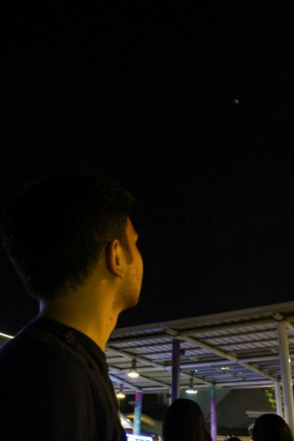
According to Photography Talk, night sky photography isn’t limited to photos of the stars; here, you can also capture constellations, star trails, the northern lights, and the Milky Way itself. Just how much detail you get in your photos depends on your camera.
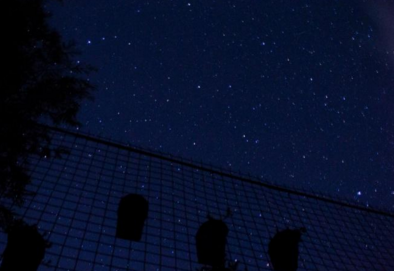
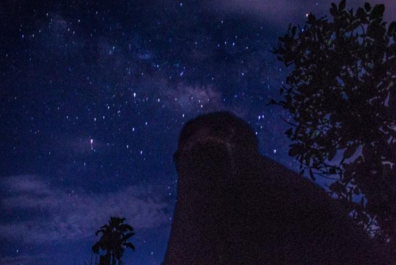
Piggyback Photography
To capture the night sky, one will need a telescope on which to mount the camera. According to Weasner, a website that discusses Astronomy-related topics, this set-up allows the telescope to track the movement of the night sky, compensating for the Earth’s rotation.
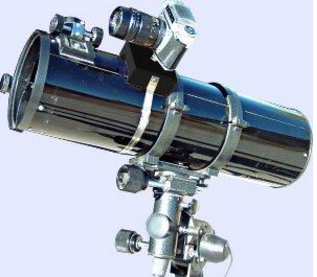
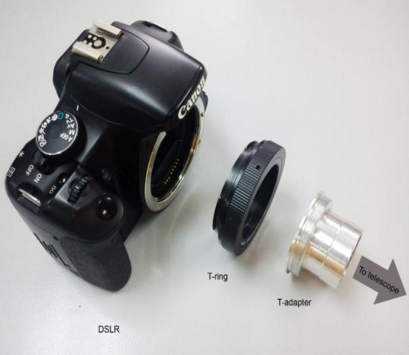
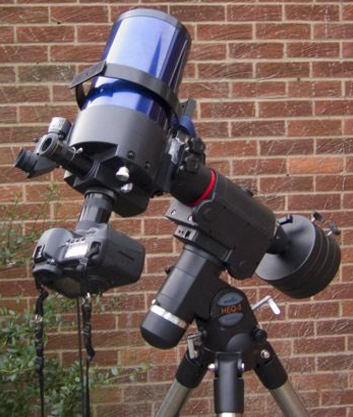
According to Astronomy for Beginners,Prime-Focus Photography gives a surprisingly small image, so it’s not ideal for capturing planets. But its advantage is that it can capture any celestial object in the night sky unseen by the naked eye.
Afocal Astrophotography
To do this, one needs to center the telescope’s eyepiece to the desired celestial object before holding the camera over the eyepiece. You can take a lot of photos of the object that is aligned or at the center of the eyepiece. The good news is you can use your mobile phone for this method as done in the photo below.
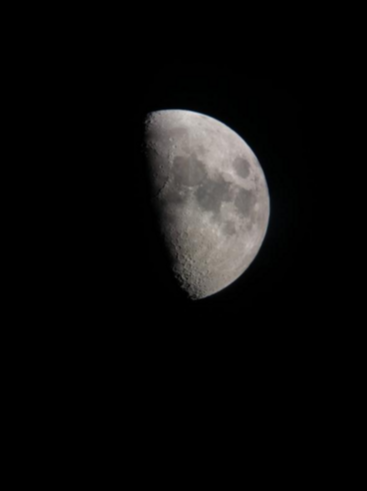
Eyepiece Projection Astrophotography
Like the Afocal Astrophotography, you will need to attach the camera to the telescope with the use of the T-ring and the camera-to-telescope adapter. But this time, the eyepiece will also be attached to the camera. According to Weasner, the eyepiece is inserted into the large tube of the adapter, which is then inserted into the eyepiece holder on the telescope. The camera is attached to the adapter using a T-Ring. The image from the eyepiece is “projected” onto the camera film or sensor. Objects tend to be fainter when imaged with this technique, due to the projection.
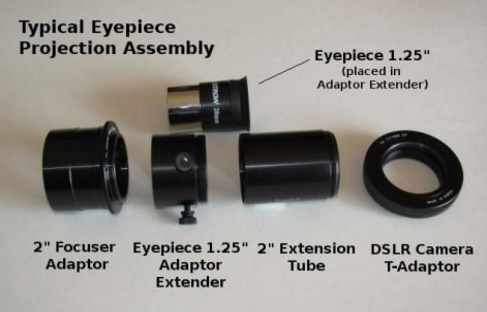

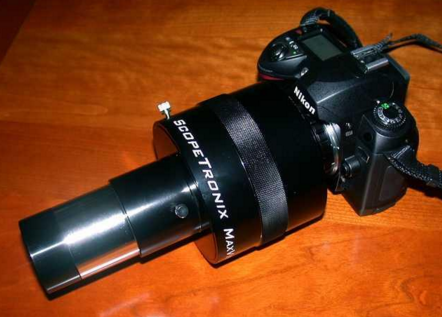
Taking photos in an urban area
Light pollution in urban areas makes astrophotography challenging. In a place like Manila, which is surrounded by tall buildings and city lights, the night sky is more likely to be obscured. Try to find a spot away from artificial lights and sky clutter to maximize your photo taking.
Dos and Don’ts of Astrophotography
- DO plan your location.
- DO bring flashlights so you can find your way around in a dark location.
- DO bring red cellophane for the flashlights. This allows your eyes to adjust to the night sky.
- DO observe and appreciate the beauty of the night sky.
- DO observe your surroundings to ensure your safety.
- DO bring company or a friend.
- DO bring a mat so you can lie down and relax while observing the night sky.
- DO bring snacks, but make sure you bring home your trash.
- DO fully charge your phone and bring powerbanks.
- DO bring an umbrella in case rain pours.
DON’TS
- DON’T use flash photography. This obscures the image you want to capture.
- DON’T fall asleep while waiting for the astronomical event.
- DON’T wear clothes that are not comfortable.
- DON’T talk too loud or make noises that will disturb the neighbors.
Taking photos of the night sky and other celestial objects requires patience and dedication. Observing the sky is fun, but it’s even more fulfilling if you capture the moment using the various methods of astrophotography.
BY Ronalyn Tindog, PanahonTV Intern
